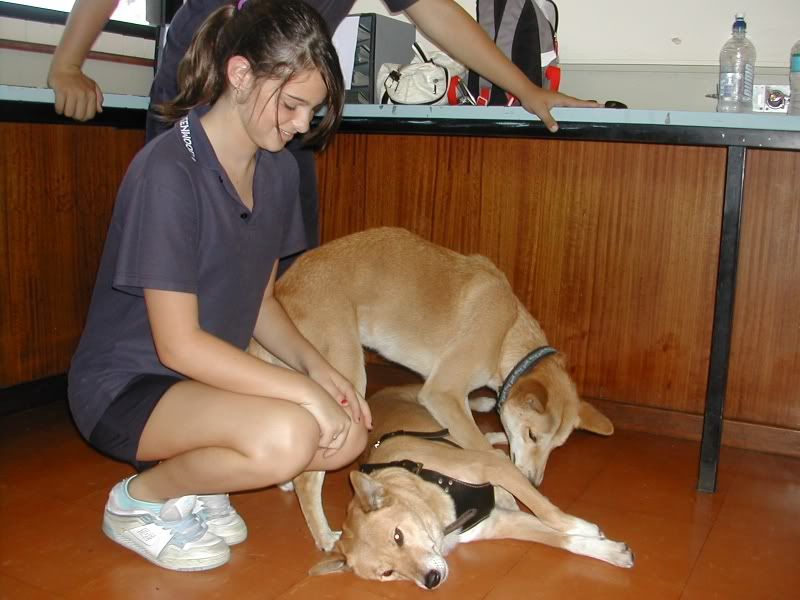
DINGOES TOUTED AS WILDLIFE'S SAVIOUR
Dani Cooper
ABC Science OnlineDingoes should be reintroduced into large tracts of Australian sheep grazing country to control feral animals that would otherwise threaten native fauna, a wildlife expert says.
Professor Chris Dickman, of the Institute of Wildlife Research at the University of Sydney, also says it may be time to consider pulling down the dingo fence that was built in the 1880s to keep dingoes from livestock in southeast Australia.
He says Australians, particularly the livestock farming community, need to rethink their attitude towards the country's native dog.
In a range of papers to be presented this week at the Biodiversity Extinction Crisis Conference in Sydney, Dickman and his colleagues argue the dingo is critical to saving threatened native species and restoring biodiversity in areas that have been devastated by drought and sheep farming.
Dickman says Australia has the world's highest rate of mammal extinction with 27 species and sub-species lost since European settlement in 1788, 'which is as much as the rest of the world combined in the same period'.
Research shows two introduced predators, the red fox and feral cat, are the main cause of many extinctions and reductions in mammal species and that dingoes keep down their numbers.
'Where dingoes occur in big numbers, cats and foxes don't,' Dickman says.
His study of the 325,000 square kilometre rangeland region of western New South Wales (NSW) shows 72 native species have been lost and 40% of the original marsupial population has disappeared from the area he describes as a 'conservation wasteland'.
Threatened
He says the reintroduction of the dingo, tied with sympathetic management practices, could help save 21 nationally or regionally threatened species of native mammals in the area.
'Such management should begin in national parks and private conservation areas and supplant sheep flocks in areas where these are now ecologically and economically unsustainable,' he says.
Those areas include western NSW, parts of Central Queensland and the southwest corner of Western Australia.
He has targeted Sturt National Park in the far-western corner of NSW as the site to begin the scheme.
Dickman says rural communities need to be encouraged to allow the dingo, Australia's largest land predator, into livestock farming areas.
In the US, he says, there are programs that help sheep and predators such as grey wolves and coyotes co-exist.
Donkeys stand guard
These include schemes to compensate farmers for killed livestock and the use of guard animals such as donkeys and alpacas that attack predators when they approach sheep.
'These schemes have worked elsewhere, we just haven't been brave enough to raise them,' Dickman says.
The ecologist has another Australian icon in his sights, suggesting it is time to debate the future of the dingo fence, which stretches 5400 kilometres across the continent from Western Australia to Queensland.
The dingo fence is a 'disaster from a biological point of view', Dickman says because of the increase in fox and cat numbers and decrease in small mammal numbers in areas where the dingoes are locked out of.
But he concedes it 'won't come down any time soon'.
'At the moment you've got a bunch of scientists saying the dingo is great ... but we know the idea is going to get nowhere unless we engage much more forcefully with the agricultural community,' he says.
Dingoes to the rescue of threatened species
From The Australian
By Leigh Dayton
July 11, 2007 12:00am
Based on research in a 325,000sq km rangeland region of New South Wales, Chris Dickman of the University of Sydney claims Canis lupus dingo could help protect 21 nationally or regionally threatened species of native animals living in the semi-arid heartland of Australia.
'It's fair to say it's not a popular idea,' Professor Dickman said at an international biodiversity conference held at the University of NSW.
According to Professor Dickman, dingoes would help to control feral foxes and cats that he claimed were behind the decrease in numbers and extinction of small animals such as the NSW bilby and species of native mice.
He said 40 per cent of marsupials and 75 per cent of native mice are now extinct in semi-arid regions of western NSW, central Queensland and parts of Western Australia.
'It's unparalleled,' he said of the loss.
Pointing to experience in the US, where wolves and coyotes have been reintroduced to rangelands as well as to wild areas, Professor Dickman said: 'There are ways to encourage people (to accept reintroduction) where livestock occurs.'
Professor Dickman claimed that work in the study area revealed that dingoes are often wrongly blamed for damage to livestock.
The usual culprits, he said, were 'town dogs'.

No comments:
Post a Comment